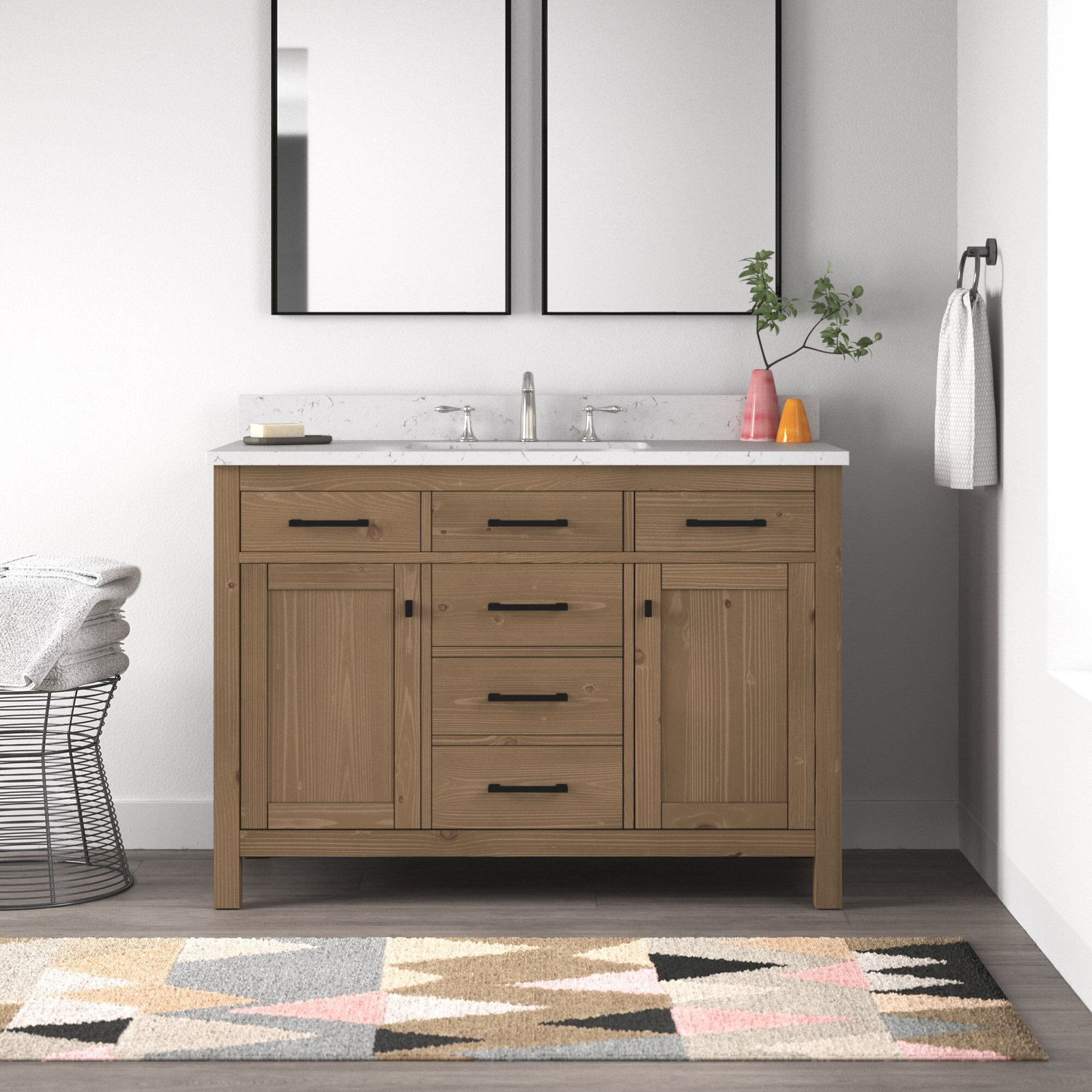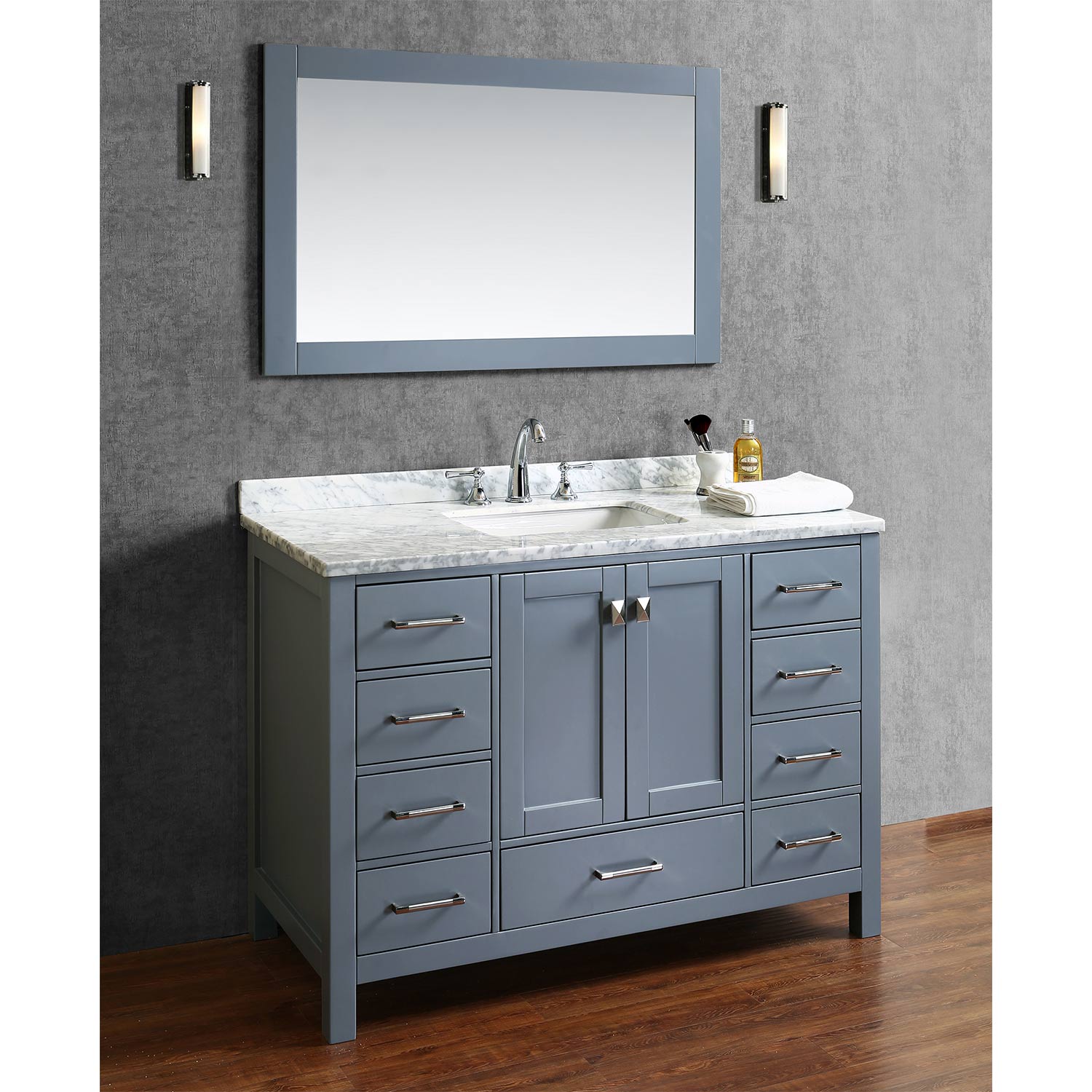Understanding the 48 Inch Unfinished Bathroom Vanity

A 48-inch unfinished bathroom vanity is a versatile piece of furniture that allows you to customize your bathroom to your exact specifications. It provides a blank canvas for your creative vision, allowing you to choose the stain, paint, and hardware that best complement your bathroom’s style.
Typical Features and Dimensions
A 48-inch unfinished bathroom vanity typically features a countertop with a sink, storage cabinets or drawers, and a backsplash. The countertop can be made from a variety of materials, including granite, marble, quartz, or laminate. The cabinets and drawers provide ample storage space for bathroom essentials. The backsplash protects the wall behind the sink from splashes and spills. The overall dimensions of a 48-inch vanity are typically 48 inches wide, 21-22 inches deep, and 34-36 inches high. These dimensions can vary slightly depending on the manufacturer and design.
Unfinished vs. Pre-Finished Vanities
Unfinished vanities offer the advantage of complete customization, allowing you to choose the perfect finish for your bathroom. You can select the stain or paint color, and apply multiple coats for a durable and long-lasting finish. However, finishing an unfinished vanity requires time, effort, and some woodworking skills.
Pre-finished vanities, on the other hand, come with a factory-applied finish. This saves you time and effort, but limits your customization options. You are restricted to the pre-selected finish, which may not perfectly match your bathroom’s decor.
Types of Wood for Bathroom Vanities
Bathroom vanities are typically made from durable hardwoods that can withstand the moisture and humidity of a bathroom environment. Some popular wood choices include:
- Oak: Known for its strength, durability, and beautiful grain patterns, oak is a popular choice for bathroom vanities. It can be stained in a variety of colors to complement different styles.
- Maple: Maple is another strong and durable hardwood that is resistant to moisture. It has a smooth, fine grain that can be stained or painted to achieve a variety of looks.
- Cherry: Cherry wood is known for its rich reddish-brown color and beautiful grain patterns. It is a relatively soft wood, but its durability can be enhanced with proper finishing.
- Walnut: Walnut wood has a distinctive dark brown color and a striking grain pattern. It is a strong and durable hardwood that is well-suited for bathroom vanities.
The choice of wood depends on your personal preferences and budget.
Prepping and Finishing an Unfinished Vanity
Prepping and finishing an unfinished vanity is a rewarding process that allows you to create a truly unique piece of furniture for your bathroom. Here is a step-by-step guide:
- Sand the vanity: Begin by sanding the vanity with progressively finer grit sandpaper to remove any rough edges or imperfections. This will create a smooth surface for the finish to adhere to.
- Clean the vanity: After sanding, wipe the vanity with a damp cloth to remove any dust or debris. Ensure the surface is completely dry before proceeding to the next step.
- Apply a wood conditioner: A wood conditioner helps to even out the wood’s grain and create a more uniform finish. Apply a thin coat of conditioner according to the manufacturer’s instructions and allow it to dry completely.
- Apply stain (optional): If you desire a stained finish, apply a thin coat of stain according to the manufacturer’s instructions. Allow the stain to dry completely before proceeding to the next step.
- Apply a sealant: A sealant protects the wood from moisture and helps to preserve the finish. Apply a thin coat of sealant according to the manufacturer’s instructions and allow it to dry completely.
- Apply paint (optional): If you prefer a painted finish, apply a primer to the vanity and allow it to dry completely. Then, apply two or three coats of paint, allowing each coat to dry completely before applying the next.
- Install hardware: Once the finish is dry, install the vanity hardware, such as knobs, pulls, and hinges.
Choosing the Right 48 Inch Unfinished Bathroom Vanity

A 48-inch unfinished bathroom vanity offers a blank canvas for your creative vision, allowing you to customize it to perfectly complement your bathroom’s style and needs. Selecting the right vanity involves careful consideration of several factors, ensuring a harmonious blend of functionality and aesthetics.
Style Considerations
The style of your vanity should align with the overall design theme of your bathroom. A traditional bathroom might favor a vanity with intricate carvings and ornate details, while a modern bathroom might prefer a sleek, minimalist design with clean lines.
Storage Needs, 48 inch unfinished bathroom vanity
Assess your storage requirements. A 48-inch vanity provides ample space, but you’ll want to ensure it accommodates all your necessities. Consider the number of drawers, shelves, and cabinets you need to store toiletries, towels, and other bathroom essentials.
Countertop Material
The countertop material is a key design element that impacts both aesthetics and functionality. Popular choices include:
- Granite: Durable, heat-resistant, and comes in a wide range of colors and patterns.
- Marble: Elegant and luxurious, but requires regular sealing to prevent staining.
- Quartz: Engineered stone that is non-porous, stain-resistant, and available in various colors and patterns.
- Laminate: Affordable and easy to maintain, but less durable than natural stone.
Bathroom Design Integration
The vanity should seamlessly integrate with your bathroom’s overall design. Consider the color palette, tile choices, and other fixtures to ensure a cohesive and harmonious look.
Accurate Measurements
Measuring your bathroom space accurately is crucial to ensure the vanity fits correctly. Measure the available width, depth, and height, leaving ample space for doors to open and for comfortable movement.
Sink and Faucet Options
The sink and faucet choices play a significant role in both functionality and aesthetics. Consider the following:
- Undermount Sinks: Offer a sleek, integrated look with a seamless countertop transition.
- Top-Mount Sinks: A classic option that sits on top of the countertop, offering ease of installation.
- Vessel Sinks: Stylish and modern, with a bowl that sits above the countertop.
- Single-Handle Faucets: Offer convenient water temperature and flow control with a single lever.
- Two-Handle Faucets: Traditional and elegant, with separate controls for hot and cold water.
- Wall-Mounted Faucets: Create a minimalist and modern look, with the faucet mounted on the wall.
Installing and Finishing a 48 Inch Unfinished Bathroom Vanity
Installing and finishing a 48-inch unfinished bathroom vanity can be a rewarding DIY project, allowing you to customize your bathroom with a unique look and feel. This guide will walk you through the process, from the initial installation to the final finishing touches, ensuring a beautiful and functional vanity.
Installing the Vanity
Before beginning the installation, ensure you have all necessary tools and materials. This includes a level, measuring tape, pencil, drill, screwdriver, stud finder, safety glasses, and work gloves. For plumbing, you will need a basin wrench, adjustable wrench, pipe cutters, Teflon tape, and a drain assembly. For electrical connections, you will need wire strippers, a voltage tester, and a wire connector.
Once you have gathered your tools and materials, you can begin the installation process:
- Prepare the Area: Clear the area around the installation site and protect the floor with drop cloths. Turn off the water supply to the bathroom. Disconnect the existing plumbing fixtures, if applicable.
- Position the Vanity: Determine the desired location for the vanity and ensure it is level. Use a level and a pencil to mark the wall where the vanity will be mounted.
- Mount the Vanity: Use a stud finder to locate wall studs. Secure the vanity to the wall using screws or anchors, depending on the wall material. If the vanity is designed for a countertop, install the countertop according to the manufacturer’s instructions.
- Connect Plumbing: Connect the vanity’s plumbing to the existing water supply lines. Use Teflon tape on the threads of the fittings to prevent leaks. Attach the drain assembly to the vanity and connect it to the bathroom drain.
- Connect Electrical: If the vanity includes a light or electrical outlet, connect the wiring according to the manufacturer’s instructions and local electrical codes. Always double-check the connections and ensure they are secure.
- Test and Finish: Turn on the water supply and test the vanity’s plumbing and electrical connections. Once you are satisfied with the installation, you can move on to finishing the vanity.
Finishing the Vanity
The finishing process allows you to personalize your vanity with a unique look and feel. You can choose from a variety of finishes, including paint, stain, or other coatings.
- Prepare the Surface: Before applying any finish, ensure the vanity surface is clean and free of dust, debris, or grease. Sand the surface lightly to create a smooth and even finish. If using stain, apply a wood conditioner to help the stain penetrate evenly.
- Apply Finish: Choose your desired finish and apply it according to the manufacturer’s instructions. For paint, apply multiple thin coats to ensure even coverage. For stain, apply the stain in the direction of the wood grain. Allow each coat to dry completely before applying the next.
- Seal the Vanity: To protect the vanity from water damage, apply a sealant. This will create a barrier that prevents water from penetrating the wood. Choose a sealant that is specifically designed for bathroom use. Apply the sealant according to the manufacturer’s instructions.
Protecting the Vanity
Once your vanity is installed and finished, it’s essential to protect it from water damage.
- Use a Splash Guard: Install a splash guard behind the sink to prevent water from splashing onto the vanity.
- Wipe Up Spills Immediately: If water spills onto the vanity, wipe it up immediately to prevent water from soaking into the wood.
- Maintain Proper Ventilation: Ensure adequate ventilation in the bathroom to prevent moisture buildup. This can be achieved by using a fan or opening a window.
